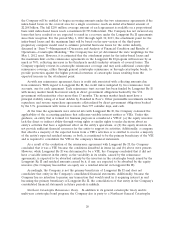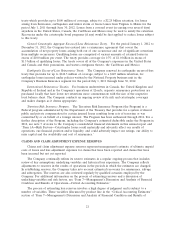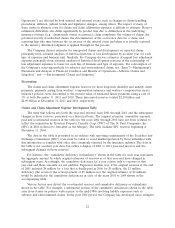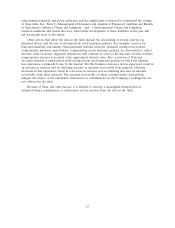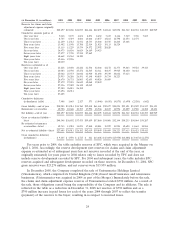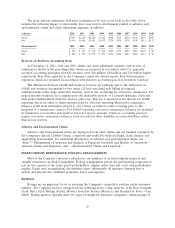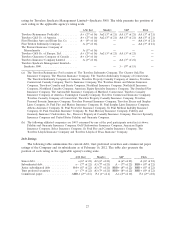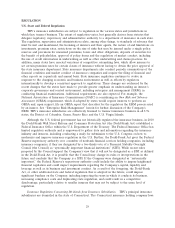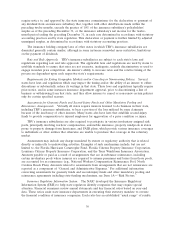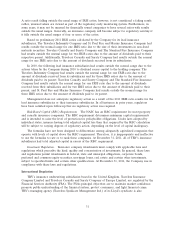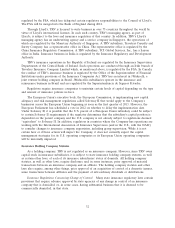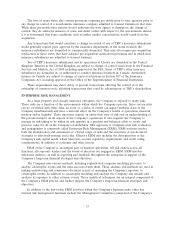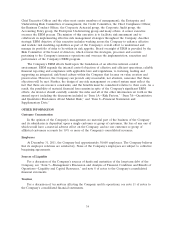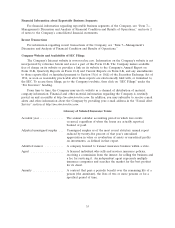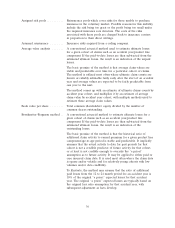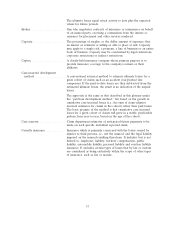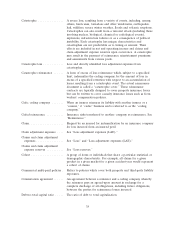Travelers 2011 Annual Report Download - page 42
Download and view the complete annual report
Please find page 42 of the 2011 Travelers annual report below. You can navigate through the pages in the report by either clicking on the pages listed below, or by using the keyword search tool below to find specific information within the annual report.require notice to, and approval by, the state insurance commissioner for the declaration or payment of
any dividend from an insurance subsidiary that, together with other distributions made within the
preceding twelve months, exceeds the greater of 10% of the insurance subsidiary’s policyholders’
surplus as of the preceding December 31, or the insurance subsidiary’s net income for the twelve-
month period ending the preceding December 31, in each case determined in accordance with statutory
accounting practices and by state regulation. This declaration or payment is further limited by adjusted
unassigned surplus, as determined in accordance with statutory accounting practices.
The insurance holding company laws of other states in which TRV’s insurance subsidiaries are
domiciled generally contain similar, although in some instances somewhat more restrictive, limitations
on the payment of dividends.
Rate and Rule Approvals. TRV’s insurance subsidiaries are subject to each state’s laws and
regulations regarding rate and rule approvals. The applicable laws and regulations are used by states to
establish standards to ensure that rates are not excessive, inadequate, unfairly discriminatory or used to
engage in unfair price competition. An insurer’s ability to increase rates and the relative timing of the
process are dependent upon each respective state’s requirements.
Requirements for Exiting Geographic Markets and/or Canceling or Nonrenewing Policies. Several
states have laws and regulations which may impact the timing and/or the ability of an insurer to either
discontinue or substantially reduce its writings in that state. These laws and regulations typically require
prior notice, and in some instances insurance department approval, prior to discontinuing a line of
business or withdrawing from that state, and they allow insurers to cancel or non-renew certain policies
only for certain specified reasons.
Assessments for Guaranty Funds and Second-Injury Funds and Other Mandatory Pooling and
Reinsurance Arrangements. Virtually all states require insurers licensed to do business in their state,
including TRV’s insurance subsidiaries, to bear a portion of the loss suffered by some claimants
because of the insolvency of other insurers. Many states also have laws that establish second-injury
funds to provide compensation to injured employees for aggravation of a prior condition or injury.
TRV’s insurance subsidiaries are also required to participate in various involuntary assigned risk
pools, principally involving workers’ compensation, automobile insurance, property windpools in states
prone to property damage from hurricanes, and FAIR plans, which provide various insurance coverages
to individuals or other entities that otherwise are unable to purchase that coverage in the voluntary
market.
Assessments may include any charge mandated by statute or regulatory authority that is related
directly or indirectly to underwriting activities. Examples of such mechanisms include, but are not
limited to, the Florida Hurricane Catastrophe Fund, Florida Citizens Property Insurance Corporation,
Louisiana Citizens Property Insurance Corporation, and the Texas Windstorm Insurance Association.
Amounts payable or paid as a result of arrangements that are in substance reinsurance, including
certain involuntary pools where insurers are required to assume premiums and losses from those pools,
are accounted for as reinsurance (e.g., National Workers Compensation Reinsurance Pool, North
Carolina Beach Plan). Amounts related to assessments from arrangements that are not reinsurance are
reported as a component of ‘‘General and Administrative Expenses.’’ For additional information
concerning assessments for guaranty funds and second-injury funds and other mandatory pooling and
reinsurance agreements including state-funding mechanisms, see Item 1A—‘‘Risk Factors.’’
Insurance Regulatory Information System. The NAIC developed the Insurance Regulatory
Information System (IRIS) to help state regulators identify companies that may require special
attention. Financial examiners review annual statements and key financial ratios based on year-end
data. These ratios assist state insurance departments in executing their statutory mandate to oversee
the financial condition of insurance companies. Each ratio has an established ‘‘usual range’’ of results.
30


